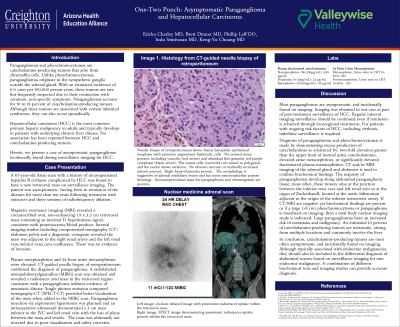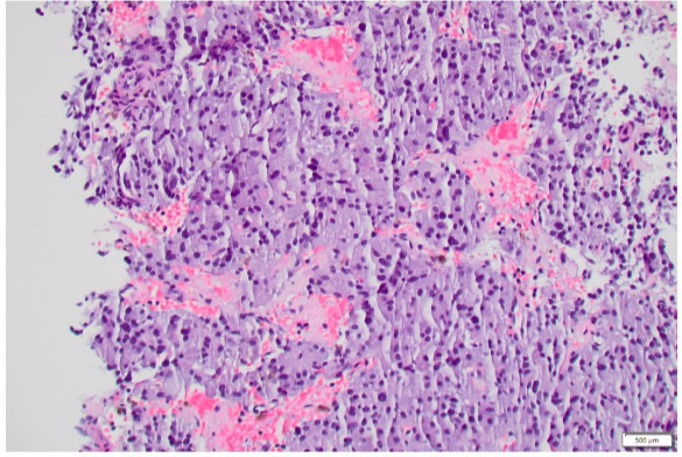Tuesday Poster Session
Category: Liver
P3977 - One-Two Punch: Asymptomatic Paraganglioma and Hepatocellular Carcinoma
Tuesday, October 24, 2023
10:30 AM - 4:00 PM PT
Location: Exhibit Hall

Has Audio
- EC
Ericka Charley, MD
Creighton University Phoenix
Mesa, AZ
Presenting Author(s)
Ericka Charley, MD1, Brett A. Dinner, MD2, Phillip Leff, DO2, Keng-Yu Chuang, MD3
1Creighton University Phoenix, Mesa, AZ; 2Creighton University, Phoenix, AZ; 3Valleywise Health, Phoenix, AZ
Introduction: Paragangliomas and pheochromocytomas are catecholamine-producing tumors that arise from chromaffin cells. Unlike pheochromocytomas, paragangliomas originate in the sympathetic ganglia outside the adrenal gland. With an estimated incidence of 0.6 cases per 100,000 person years, these tumors are rare but frequently suspected due to their connection with common, non-specific symptoms. Paragangliomas account for 10-15 percent of catecholamine-producing tumors. Although these tumors are associated with certain inherited syndromes, they can also occur sporadically.
Hepatocellular carcinoma (HCC) is the most common primary hepatic malignancy in adults and typically develops in patients with underlying chronic liver disease. No association has been reported between HCC and catecholamine-producing tumors. Herein, we present a case of asymptomatic paraganglioma incidentally found during surveillance imaging for HCC.
Case Description/Methods: A 67-year-old man with a history of decompensated hepatitis B cirrhosis complicated by hepatocellular carcinoma (HCC) was found to have a new retrocaval mass on surveillance imaging. The patient was asymptomatic, having been in remission of the diseases for more than ten years following treatment with Entecavir and three sessions of radiofrequency ablation. MRI revealed a circumscribed oval, non-enhancing 1.9 x 3.2 cm retrocaval mass containing an internal T1 hyperintense signal, consistent with proteinaceous/blood product. Multiple interval CT abdomen pelvis and a diagnostic venogram revealed that the mass abutted the right renal artery and the left renal vein-inferior vena cava confluence without evidence of invasion. Plasma norepinephrine and 24-hour urine metanephrines were elevated. A CT guided biopsy confirmed the diagnosis of paraganglioma (Figure 1). Adrenal SPECT-CT showed no evidence of metastatic disease. Paraganglioma resection via exploratory laparotomy with intraoperative ultrasound was attempted yet aborted due to poor visualization of and inability to safely resect the mass.
Discussion: Paragangliomas and pheochromocytomas are rare tumors. Over half of catecholamine-producing tumors are asymptomatic, including normotensive, and found incidentally on imaging as in this case report. Diagnosis of paragangliomas relies on 24-hour urine catecholamine testing and advanced nuclear medicine modalities for localization.

Disclosures:
Ericka Charley, MD1, Brett A. Dinner, MD2, Phillip Leff, DO2, Keng-Yu Chuang, MD3. P3977 - One-Two Punch: Asymptomatic Paraganglioma and Hepatocellular Carcinoma, ACG 2023 Annual Scientific Meeting Abstracts. Vancouver, BC, Canada: American College of Gastroenterology.
1Creighton University Phoenix, Mesa, AZ; 2Creighton University, Phoenix, AZ; 3Valleywise Health, Phoenix, AZ
Introduction: Paragangliomas and pheochromocytomas are catecholamine-producing tumors that arise from chromaffin cells. Unlike pheochromocytomas, paragangliomas originate in the sympathetic ganglia outside the adrenal gland. With an estimated incidence of 0.6 cases per 100,000 person years, these tumors are rare but frequently suspected due to their connection with common, non-specific symptoms. Paragangliomas account for 10-15 percent of catecholamine-producing tumors. Although these tumors are associated with certain inherited syndromes, they can also occur sporadically.
Hepatocellular carcinoma (HCC) is the most common primary hepatic malignancy in adults and typically develops in patients with underlying chronic liver disease. No association has been reported between HCC and catecholamine-producing tumors. Herein, we present a case of asymptomatic paraganglioma incidentally found during surveillance imaging for HCC.
Case Description/Methods: A 67-year-old man with a history of decompensated hepatitis B cirrhosis complicated by hepatocellular carcinoma (HCC) was found to have a new retrocaval mass on surveillance imaging. The patient was asymptomatic, having been in remission of the diseases for more than ten years following treatment with Entecavir and three sessions of radiofrequency ablation. MRI revealed a circumscribed oval, non-enhancing 1.9 x 3.2 cm retrocaval mass containing an internal T1 hyperintense signal, consistent with proteinaceous/blood product. Multiple interval CT abdomen pelvis and a diagnostic venogram revealed that the mass abutted the right renal artery and the left renal vein-inferior vena cava confluence without evidence of invasion. Plasma norepinephrine and 24-hour urine metanephrines were elevated. A CT guided biopsy confirmed the diagnosis of paraganglioma (Figure 1). Adrenal SPECT-CT showed no evidence of metastatic disease. Paraganglioma resection via exploratory laparotomy with intraoperative ultrasound was attempted yet aborted due to poor visualization of and inability to safely resect the mass.
Discussion: Paragangliomas and pheochromocytomas are rare tumors. Over half of catecholamine-producing tumors are asymptomatic, including normotensive, and found incidentally on imaging as in this case report. Diagnosis of paragangliomas relies on 24-hour urine catecholamine testing and advanced nuclear medicine modalities for localization.

Figure: Figure 1. Paraganglioma pathology
Disclosures:
Ericka Charley indicated no relevant financial relationships.
Brett Dinner indicated no relevant financial relationships.
Phillip Leff indicated no relevant financial relationships.
Keng-Yu Chuang indicated no relevant financial relationships.
Ericka Charley, MD1, Brett A. Dinner, MD2, Phillip Leff, DO2, Keng-Yu Chuang, MD3. P3977 - One-Two Punch: Asymptomatic Paraganglioma and Hepatocellular Carcinoma, ACG 2023 Annual Scientific Meeting Abstracts. Vancouver, BC, Canada: American College of Gastroenterology.
